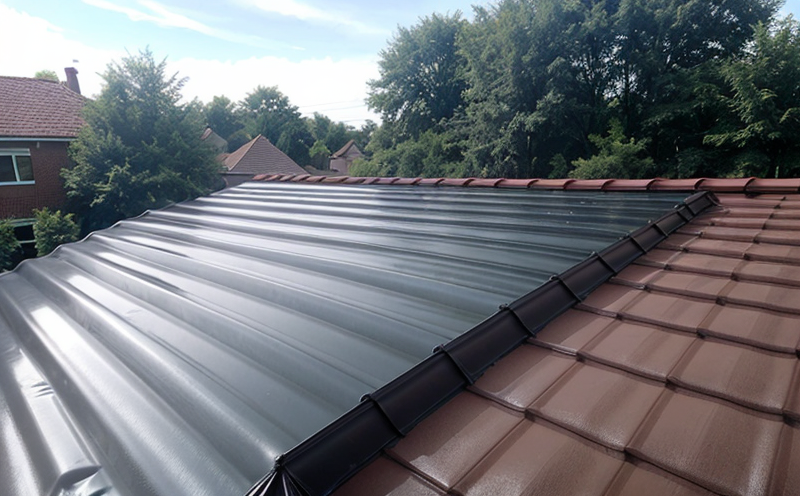EN 12311 Tensile Properties of Roofing Sheets
The EN 12311 standard is pivotal in determining the tensile properties of roofing sheets, a critical aspect for ensuring the structural integrity and durability of building envelopes. This test evaluates how much force or tension can be applied to the roofing material before it starts to deform or fail. The results are essential for construction professionals who aim to select materials that meet specific performance criteria under varying environmental conditions.
The tensile properties of roofing sheets are influenced by several factors, including the type of polymer used in the composition of the sheet, its thickness, and the quality of the manufacturing process. These properties play a significant role in determining how well the roof can resist wind uplift, snow loads, and other environmental stresses over time.
Compliance with EN 12311 ensures that roofing materials meet stringent international standards for performance, safety, and durability. This standard is particularly relevant in regions prone to severe weather conditions where the integrity of roofs is paramount. By adhering to this standard, manufacturers can ensure their products are fit for purpose and can withstand the rigors of real-world use.
The test procedure outlined in EN 12311 involves subjecting a specimen cut from the roofing sheet to tension until it fails. The tensile strength (ultimate tensile strength) is measured as well as the elongation at break, which indicates how much stretching the material can endure before failure occurs.
For accurate and reliable testing, it is crucial to follow all prescribed steps meticulously. This includes selecting appropriate specimens, ensuring they are prepared correctly, calibrating test equipment properly, and conducting tests under controlled environmental conditions to eliminate external variables that could affect results.
The importance of this test extends beyond mere compliance; it significantly impacts the quality assurance processes within roofing manufacturing plants. By implementing EN 12311, companies can enhance their reputation for producing high-quality products while also demonstrating a commitment to sustainability by selecting materials that are both effective and environmentally friendly.
Moreover, compliance with this standard facilitates smoother interactions between manufacturers, installers, and end-users. It ensures everyone involved in the roofing process understands the expected performance levels of the material being used, thereby reducing instances of premature failures or non-compliance issues down the line.
Applied Standards
| Standard | Description |
|---|---|
| EN 12311-1:2008 | Determination of tensile properties of roofing sheets - Part 1: General requirements and test methods |
| ASTM D6574 | Tensile properties of single-ply roofing membranes by strip testing |
| ISO 12998-1 | Determination of tensile properties of single-ply roofing membranes - Part 1: General requirements and test methods |
The application of these standards ensures consistency in testing procedures across different laboratories and jurisdictions, providing a reliable basis for comparing results. Compliance with international standards like EN 12311 also opens doors to broader markets by meeting global quality benchmarks.
Benefits
The implementation of the EN 12311 standard offers numerous benefits that extend beyond mere compliance requirements:
Enhanced Product Quality: By adhering to this standard, manufacturers can ensure their roofing sheets meet stringent performance criteria.
Increased Safety: Properly tested materials contribute significantly to the safety and durability of buildings.
Sustainability: Selecting materials that pass these rigorous tests supports sustainable practices by ensuring longevity and reduced maintenance costs over time.
Market Access: Compliance with international standards like EN 12311 helps manufacturers access broader markets, enhancing their competitive edge.
In summary, the benefits of implementing the EN 12311 standard are multifaceted, encompassing quality assurance, safety measures, sustainability initiatives, and market expansion opportunities. These advantages translate into improved customer satisfaction and long-term business success for roofing material manufacturers.
Competitive Advantage and Market Impact
Meeting global standards like EN 12311 enhances a manufacturer's reputation, making them more attractive to international buyers.
Ensuring compliance demonstrates a commitment to quality and safety, which can differentiate products in competitive markets.
By providing reliable data on tensile properties, manufacturers can better market their roofing sheets as superior choices for demanding applications.
The impact of this standard is profound, not only benefiting individual companies but also contributing to the overall quality and safety of buildings worldwide. It plays a vital role in shaping the future of the construction industry by setting high standards that promote innovation and excellence.





